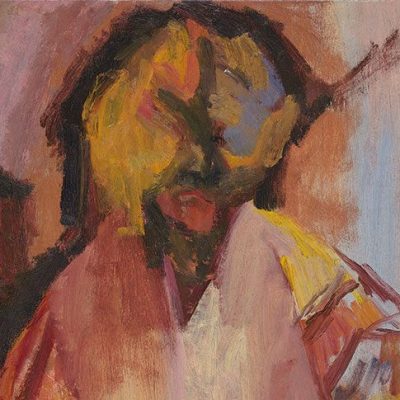Bringing together in the same exhibition works by David Bomberg and Frank Auerbach might seem like a convenient piece of art historical bracketing, but the curators at Daniel Katz Gallery have created some telling juxtapositions. Both artists are considered members of the so-called School of London, but come from different generations: Bomberg, born in 1890, was a contemporary of Mark Gertler, C.R.W. Nevinson and William Roberts, while Auerbach, 40 years younger, is associated more with Leon Kossoff and Lucian Freud. There is, however, a direct connection: the classes that Bomberg taught at the Borough Polytechnic in the late 1940s, which Auerbach attended and has since cited as deeply formative.
The show includes many more paintings and drawings by Bomberg than by Auerbach, but that is no bad thing. Bomberg’s work is less frequently exhibited and less well known than it ought to be. There are two early works – both intensely dynamic and rigorously analytical responses to the human figure in motion – which reveal a direct affinity with Vorticist methods of composition, but the rest of Bomberg’s contributions are nearly all landscapes and townscapes, alongside two very arresting portraits.
Pool of Hezekiah, Jerusalem (1925), David Bomberg. Daniel Katz Gallery, London

The earliest landscapes shown here were painted in Palestine, where Bomberg lived from 1924–27. There are panoramic views of Jerusalem that maintain a representational decorum, though the brushwork is already emphatic and seemingly on the verge of generating its own ideas, while the large canvas exploring the stone facades of Petra, where the tombs are hewn out of virgin rock, clearly records Bomberg’s enthusiasm for this conversion of the landscape into a serial work of art. The successive layers of rock take on the character of unfinished sculptures, ready for the carver to finish the job, or for the painter to project his own illusion.
The strongest paintings in the exhibition are Bomberg’s responses to the Spanish towns of Toledo, Cuenca and Ronda. These date mainly from the mid 1930s, together with two charcoal drawings from the mid 1950s. These are large paintings, their scale amplifying the drama of their hilltop and clifftop settings. As with the Petra canvas, the entire visual field is practically monopolised by the juxtaposition of bedrock and building stone. Vertiginous cliffs abut the steep and narrow streets of towns whose chromatic scale barely differs from that of the surrounding terrain; houses look like outcrops of the nearest massif, especially in the sweeping views of Toledo and Cuenca. The point of view is not actually vertical, but is often giddyingly elevated. There’s a daredevil precariousness conjured by Bomberg’s repeated invitation to peer into the abyss, but also an almost aggressive decisiveness in the brushwork that pulls all the vertical strokes downwards rather than upwards.
East Valley, Cuenca (1934), David Bomberg. Daniel Katz Gallery, London

And then there’s a very interesting painting that stands in complete contrast to the Spanish landscapes. It’s a claustrophobic study of the ‘bomb store’ – or part of it – at Fauld in Staffordshire. During the Second World War Bomberg was commissioned to produce a visual record of – and in the process a personal response to – this enormous underground munitions depot. He visited in 1942 – luckily so, since two years later the whole site blew up, leaving behind a crater 300m wide. The painting shown here is one of several similar depictions and is strikingly formalist, as well as containing echoes of Vorticist abstraction. Vorticism as projected in the programmatic statements of Wyndham Lewis was closely associated with a vocabulary of militant force. Bomberg’s painting does not echo the stridency of Lewis’s work in any way, but does seem to capture a sense of violent power waiting to be released.
There are just three paintings by Auerbach in the exhibition, all made after the death of Bomberg in 1957, but each is in dialogue with Bomberg’s work. The earliest, Mornington Crescent with the Statue of Sickert’s father-in-law (1966), actively obscures the sculpture mentioned in the title, but presumably the reference is there simply to flag up the name of Sickert as a key figure in the Camden Town Group, whose responses to the changing urban environment in many ways anticipated those of the School of London. Auerbach’s work represents a later stage in the evolution of landscape painting that uses brushwork and palette to disturb and defamiliarise the viewer’s relationship to the scene in a way that is not dissimilar from Bomberg’s unease in the bomb store. The evening setting allows for an almost nightmarish expectancy to pervade the entire canvas.
Primrose Hill (1972), Frank Auerbach. Private Collection

The most arresting thing about Auerbach’s painting of Primrose Hill from 1971 is that this suburban green space, with its modest gradient and elevation of just over 60m, has as much impact as the hilltop citadels in Andalusia and La Mancha painted by Bomberg decades earlier. The clouds over the hill are as clotted as the dark blue blocks of individual trees or the thickly pasted lines of red bushes. The grass is laid down in dramatic zigzags. This is an example of some of the most passionate landscape painting in the post-war period. But the real star of the show is Auerbach’s audacious abstraction from 1993 of Rubens’ great painting Samson and Delilah (c. 1609–10). We can just about conjure up the figures at the door, bringing a lantern to illuminate the cropping of Samson’s hair. But the titular figures and the two servant accomplices are dismembered into a seething mass of agitated trails of paint, all piled on top of one another. It is a fundamental rewriting of the story in which the victim is not like a patient, asleep while being operated on, but a living body of ordnance, about to thunder into life.
Rubens’ Samson and Delilah (1993), Frank Auerbach. Daniel Katz Gallery, London

‘Bomberg – Auerbach’ is at Daniel Katz Gallery, London, until 18 October.



